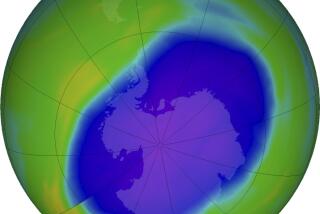Release Rate of CFCs Is Slowing, Researchers Say : Environment: International pact to phase out ozone-depleting chemical ‘is taking effect,’ UCI professor says.
- Share via
SAN FRANCISCO — The increase in concentration of chlorofluorocarbons in the atmosphere has been reduced by half since industrial nations agreed to phase out manufacture of the ozone-depleting chemical, researchers said Monday.
“An international agreement is taking effect. The countries of the world are actually following it,” said F. Sherwood Rowland of UC Irvine.
Despite that good news, experts said chlorofluorocarbons already released into the atmosphere will continue to savage ozone, the natural chemical that protects Earth from the sun’s harmful radiation.
At a symposium at the national meeting of the American Assn. for the Advancement of Science, researchers reported that the chlorofluorocarbons, or CFCs, increased at the rate of 4% annually through the 1980s, but the rate has now slowed to about 2%.
CFCs are used in refrigeration and industrial processes. They once were used as a propellant in aerosol cans.
Researchers discovered in the 1970s that the chemical broke down into chlorine in the atmosphere and that the chlorine was depleting the ozone layer. Without ozone, the Earth has no protection from ultraviolet solar rays, a form of radiation that can cause skin cancer and damage genetic material.
In 1987, industrial nations signed an agreement to phase out CFCs. That agreement has since been updated twice, with the latest calling for a ban on most CFCs by 1996.
But Rowland said some CFC molecules already in the atmosphere will take up to a century to decay.
Another researcher, C.R. Booth of Biospherical Instruments, a contractor for the National Science Foundation, said a network of instruments around the world have proven a direct link between the loss of ozone and a sharp increase in ultraviolet radiation.
Booth said instruments in Antarctica, Alaska, South America and San Diego have all detected increases in ultraviolet radiation.
“There is a strong and very predictable correlation in rises in ultraviolet light and decreases in ozone,” Booth said.
The instruments, which measure ultraviolet radiation spectra that are damaging to skin and to DNA, detected record levels of ultraviolet in the Antarctic.
At Palmer Station, a U.S. facility in Antarctica, instruments recorded in a few weeks more harmful ultraviolet radiation than is seen in an entire year in San Diego, Booth said.
This is the result of a so-called “ozone hole” that has been detected over the South Polar region every spring for a number of years. Recent measurements have detected an ozone depletion over the South Pole of up to 70% during some days.
Raymond C. Smith, a UC Santa Barbara researcher, is studying the biological effects of the decreased ozone near the South Pole. He said that beneath the ozone hole there is a 6% to 12% decline in the population of phytoplankton, a microscopic algae that is the foundation of the food chain in the far southern seas.





